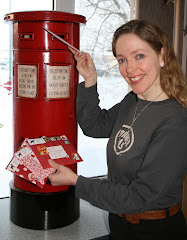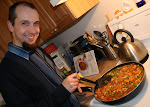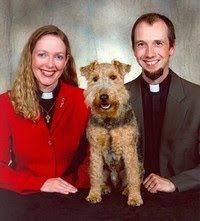by Gryffin the Welsh Terrier
Every year, I (Gryffin) write a review of the year in my own unique bark - er, voice! Some people and pups have seen it already, but in case you haven't, here it is...
Hello from Gryffin, in our backyard! If you were here in person, I’d be so glad to see you I’d jump all over you. Steve and Julie have turned me loose (or hooked me to the long, retractable leash?) to tell you about our life in 2009.
Photo: I enjoyed destroying the feather duster this spring.
We began 2009 by ringing in the New Year with our friend Chung in Calgary. While the humans all partied with friends, I enjoyed Chung’s condo, and its terrier-level garbage bins.
The winter this year had a real long cold snap. The thermometer outside my window can be distracting when I bark at people walking by, but it said -30c every night, from early December through to almost March. Brr! That meant weeks of being forced to wear my winter coat and Velcro boots on our walks. Grr...
Another sight out that window is St Patrick’s church, where Steve and Julie have shared the role of Priest-in-Charge for 2½ years. I also really like our weekly trips to Church of the Ascension in Arborfield. I get to bark at all the cows during the 120 km / 80 mile trip, then they let me run loose in the hall... sometimes.
2009 was an exciting year at the churches.
Maybe the biggest event was updating the parish Photo Directory for the first time since 1997. I even got included in our family’s photo, right in front, too!
Julie had some interesting speaking engagements this year. In March, she spoke at the annual Lay-reader Licensing service at St. Alban’s Cathedral in Prince Albert. Then in June, she was the teacher at a 3-day Ladies Retreat at Camp Okema, near Prince Albert National Park. And she spoke to several groups about the mission trip she and Steve took to Guatemala a few years ago.
In addition to their shared priest work, Steve and Julie also share the role of Associate Editor on the monthly Saskatchewan Anglican newspaper, writing and gathering stories from around the Diocese, and of Webmasters for the Diocesan website . This year, Steve also became Webmaster for The Anglican Planet monthly newspaper. And Julie continues to write travel stories for the local newspapers. Those two seem to like writing. Maybe they’ll write next year’s Gryffin-gram! Naw, I’ll probably keep this job.
In their spare time, Julie writes to her hundreds of penpals, and Steve has been working on his guitar skills. They started a monthly photo club in town too, that meets right in our house – a very exciting night for me! 8-10 people come each time - I love company! Each month, the club talks about a photography topic, and shares their photos on the month’s theme. And Julie’s card club has turned her into a card-making master.
May 6, 2009 was Steve & Julie’s 15th Anniversary – I don’t know what that would be in dog-years, but a lot. They celebrated with a week of tenting in the Black Hills, in South Dakota and Wyoming, USA. They liked what they saw so much, they went back on their big vacation trip in the summer. The full trip went through Alberta Canada, then Montana, Wyoming, Idaho, Utah, Nebraska, South Dakota and North Dakota on a tenting tour of 10 National Parks and Monuments in the “Wild West” US states.
They didn’t take me, though. I stayed home and looked after Julie’s parents, who came to visit for a few weeks in June and July. And I had lots of fun when Steve’s parents came over Christmas!
Steve & Julie went down to North Dakota one more time, in August. They took a week and tented in the badlands of Theodore Roosevelt National Park. The park is named after the 26th US President, a man who ranched in the area in the late-1800s, and did a lot for parks and conservation. He’s now one of the 4 faces on Mt. Rushmore in South Dakota. We later learned that Steve and “Teddy” are distant cousins. Steve & Julie hiked in the back-country of the park in the mornings, ever vigilant for bison and rattle-snakes, then in the afternoon, they read works by the ‘Desert Fathers and Mothers,’ 4th to 6th century Christian writers. I wish I’d been there to chase – I mean, to see and admire from a polite distance – all the prairie dogs and bison in the area.
One autumn highlight was a trip to see the Moscow Ballet perform Tchaikovsky’s The Nutcracker, in Prince Albert. Julie had always wanted to see a professional ballet, and she found it to be enthralling, a transcendent taste of culture.
You can keep up with Steve, Julie and me in lots of ways in 2010. They post cute photos of me on Flickr and we’re all on Facebook (actually, I’m on Dog-Book). Blessings in 2010!
Love, from Gryffin

























